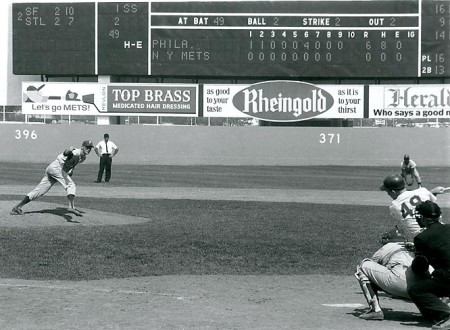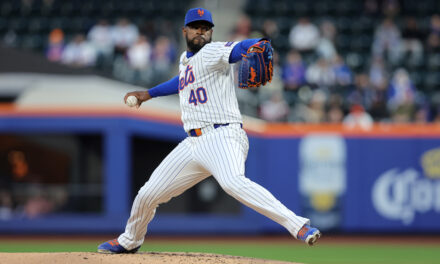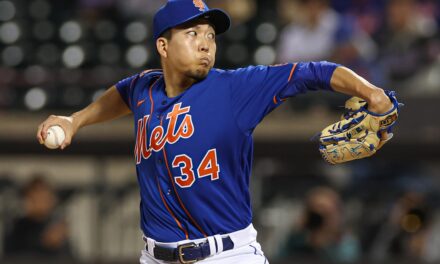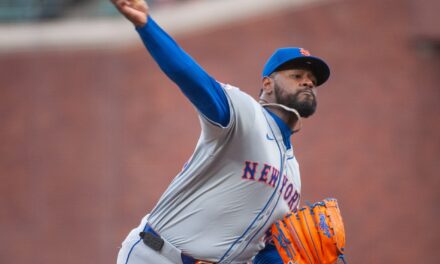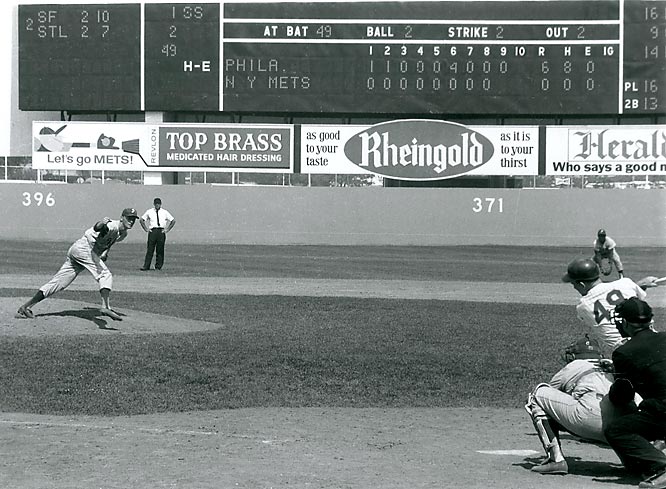
On June 20, 1964 Philadelphia Phillies starting pitcher Jim Bunning threw a perfect game against the New York Mets in the first game of a doubleheader at Shea Stadium. With his wife and children in the stands, here’s what happened …
By the eighth inning 32,904 Mets fans were cheering for the Philadelphia Phillies, for pitcher Jim Bunning. On Father’s Day 1964, the Phillies pitcher was just a handful of outs away from a perfect game.
Met fans rooting for the Phillies? This would never, under any circumstances, happen today.
But these were simpler days for Met fans. The Mets were already firmly planted in last place (20-45) in the National League, 21 games behind in the National League East. Winning a division title was nowhere in sight – nor did it matter. Mets fans celebrated wins, and losses, and the first year in their new Flushing home, Shea Stadium. Life was good. National League baseball was back in New York.
“Nobody realized it was a perfect game until the fourth or fifth inning,” former Phillies pitch Dennis Bennett told Bill Ryczek, author of The Amazin’ Mets. “You know that it’s taboo to talk about it, but Jim was talking about it.”
Bunning was reportedly very vocal about what was developing. According to catcher Gus Triandos, he’d never seen Bunning acting so animated. “He was jabbering like a magpie,” he said.
Only one other time over the first 10 years of his career did Bunning feel the same command and control of his slider. It was six years earlier (1958), as a member of the Detroit Tigers when he tossed his first career no-hitter against the Boston Red Sox.
Galen Cisco, who was playing for the Mets, said Bunning “just wasn’t missing. Everytime he tried to keep the ball away, it was away. When he got two strikes, he was throwing the ball off the plate, and we were swinging. We just weren’t very patient.”
Perfection was in jeopardy in the fifth inning when Jesse Gonder hit at line drive toward right field. Phillies second baseman Tony Taylor dove to his left, knocking down the ball and threw out Gonder at first base.
Former Met Hawk Taylor said Bunning had “won over the umpire, who was starting to widen the strike zone for him … not that he needed a lot of help, but I remember the strike zone was substantially enlarged.”
Joe Christopher added, “When you’re making good pitches and the umpire is in your corner, it’s two against one.”
Bunning had retired 24 consecutive batters when Charlie Smith stepped in to lead off the ninth inning. Smith made No. 25 easy, hitting a foul pop up to third base that was squeezed by Cookie Rojas.
Mets manager Casey Stengel pinch hit George Altman, who felt he had the advantage against Bunning, who threw side-armed. “Lefthanders got a good look at him,” Altman told Ryczek. “He’s the kind of pitcher you love to hit off. To me, it was a lot better than facing Koufax or someone like that … of course he wound up handling all of us.” Altman hit a long foul ball into the seats then promptly struck out.
Mets pitchers Tracy Stallard and Bill Wakefield, members of the fraternity, were emotionally split. Stallard wanted to see the Mets break up the perfect game, while Wakefield privately changed allegiances.
“You always want to be professional, you always want to root for your team, but it wasn’t a situation that was going to cost us the pennant, or even a position in the standings.”
Stengel sent another pinch hitter to the plate, Johnny Stephenson. The Mets rookie was 2-for-27 in his major league career. Bunning fidgeted nervously on the mound as Stephenson came to the plate.
His first two pitches to Stephenson were strikes, the first swinging, the second a called strike. Bunning missed with the next two pitches. Stephenson watched a 2-2 pitch drop into the strike zone. Bunning was perfect, throwing 86 pitches (69 strikes).
“He threw me all sliders, which were hard to pick up, the way he fell off the mound,” remembered Stephenson.
Surrounded by teammates, Bunning disappeared into the visitor’s dugout at Shea Stadium. After a few minutes of standing ovation fans launched into a chant of “We want Bunning! We want Bunning!”
When the Phillies pitcher stepped back on to the field for a post-game interview with Ralph Kiner, Mets fans exploded in cheers. Moments later, Bunning’s wife, Mary, and his eldest daughter—he has seven children—came out of the stands to kiss and hug Dad.
Ryczek wrote, “… through mid-1966, Bunning made seven starts in Shea Stadium. He had seven wins, seven complete games and four shutouts. Bu early 1967, he had allowed just three runs to the Mets in 72 innings.”
Bunning became the first pitcher in major league history to throw a no-hitter in both the American (July 20, 1958 vs. Boston) and National leagues.

